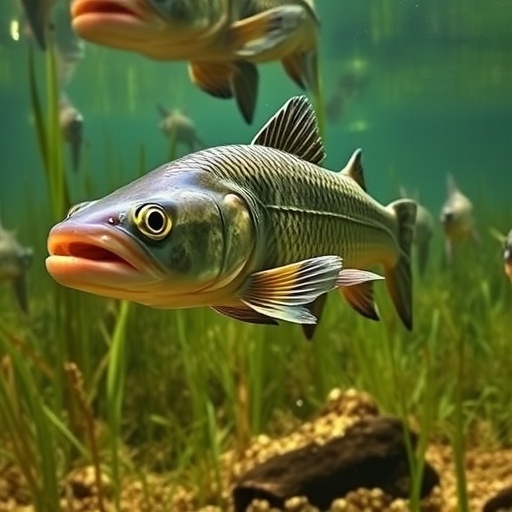Recent research has highlighted significant concerns surrounding the impact of agricultural chemicals on aquatic life, with a particular focus on atrazine, a widely used herbicide. The study conducted by Opute and Mbajiorgu, recently published in “Discover Animals,” delves into the effects of atrazine-induced intestinal histopathology in juvenile African catfish, Clarias gariepinus. This research adds to an increasingly critical body of literature that examines the ramifications of chemical contaminants on fish health and ecological balance in aquatic environments.
Atrazine has been a controversial herbicide for decades, primarily because of its extensive application in agriculture and its persistent presence in water systems. While it is effective in controlling weeds, the side effects of atrazine on nontarget species, especially aquatic organisms, are alarming. In the experiment, juvenile Clarias gariepinus were exposed to varying concentrations of atrazine to assess the resultant histopathological changes in their intestinal structure, functioning as a model for understanding the broader implications of chemical exposure in aquatic ecosystems.
Histopathology refers to the microscopic examination of tissue to study the manifestations of disease. In the context of this research, the intestinal tissues of the catfish were analyzed for abnormalities following exposure to atrazine. The team found that the herbicide significantly affected the cellular architecture of the intestine, leading to disruptions that could impair nutrient absorption and overall fish health. Such alterations suggest a worrying pattern, where chemical exposure not only threatens individual fish but potentially destabilizes entire aquatic ecosystems.
The mechanism by which atrazine exerts its damaging effects is complex, involving oxidative stress and inflammation that can lead to cellular apoptosis and necrosis. The study documented various histopathological changes, including epithelial erosion, hypertrophy, and alterations in mucosal architecture, indicating a serious compromise of gut health. These findings underscore the necessity for further investigations into the molecular pathways activated by such contaminants, which can unravel the intricate relationship between chemical exposure and fish physiology.
Moreover, the implications of these findings extend beyond the lab. Aquatic ecosystems serve as crucial indicators of environmental health. The degradation of fish health due to chemical exposure not only threatens biodiversity but also affects food security and water quality for human populations dependent on these resources. With increasing reports of agricultural runoff affecting freshwater systems globally, the research by Opute and Mbajiorgu calls for urgent action to address these pressing environmental issues.
Researchers emphasize that understanding the effects of atrazine on fish populations is essential for developing strategies to mitigate its impact. This includes evaluating the regulations surrounding herbicide use and investigating alternative methods of weed control in agriculture that are less harmful to aquatic ecosystems. Policymakers, environmentalists, and farmers must collaborate to create sustainable agricultural practices without compromising the health of natural water bodies.
Furthermore, this research contributes to an essential dialogue regarding the balance between agricultural productivity and environmental preservation. With the growing awareness of climate change and its myriad impacts, the research findings serve as a sobering reminder that the choices made in agriculture can have far-reaching consequences for biodiversity and ecosystem functionality. Sustainable practices must be prioritized, promoting less reliance on chemical inputs.
As we move forward, public awareness campaigns about the impacts of chemical runoff, like atrazine, are vital. Education plays a crucial role in helping communities understand the importance of clean waterways and the detrimental effects of pollutants. This knowledge can empower individuals and communities to advocate for stronger environmental protections and support local initiatives aimed at preserving aquatic habitats.
In conclusion, the atrazine-induced intestinal histopathology observed in juvenile Clarias gariepinus is a clarion call for renewed focus on the impact of agricultural practices on aquatic life. As we delve deeper into the intricate relationships within ecosystems, studies like those conducted by Opute and Mbajiorgu serve as invaluable resources for understanding the ripple effects of human activities on the environment. Continued research and proactive measures are essential to safeguard not only the health of fish populations but also the integrity of ecosystems as a whole.
The findings of this study have profound implications for the future of aquatic health and agricultural practices. By prioritizing sustainable farming techniques and monitoring the effects of chemical exposure, we can work towards a future where agriculture and nature coexist harmoniously, ensuring the health of our planet for generations to come. The dialogue surrounding chemical contaminants and their effects on wildlife must continue, emphasizing the need for ongoing research, public education, and policy reform to protect vital aquatic ecosystems.
In summary, the surge of interest in chemical pollutants like atrazine in aquatic environments is justified and critical for ecological health. The research conducted by Opute and Mbajiorgu provides essential insights into the detrimental effects of atrazine on juvenile catfish, offering a glimpse into broader ecological concerns. As stewards of the environment, we owe it to the planet and future generations to ensure that agriculture does not come at the expense of our natural resources. The convergence of science, policy, and community activism is key to fostering a sustainable future where fish, and the ecosystems they inhabit, can thrive.
Subject of Research: Atrazine-induced intestinal histopathology in juvenile African catfish, Clarias gariepinus.
Article Title: Atrazine-Induced Intestinal Histopathology in Juvenile African catfish, Clarias gariepinus (Burchell, 1822).
Article References:
Opute, P.A., Mbajiorgu, F.E. Atrazine-Induced Intestinal Histopathology in Juvenile African catfish, Clarias gariepinus (Burchell, 1822). Discov Anim 2, 26 (2025). https://doi.org/10.1007/s44338-025-00080-z
Image Credits: AI Generated
DOI: 10.1007/s44338-025-00080-z
Keywords: Atrazine, intestinal histopathology, Clarias gariepinus, aquatic ecosystems, environmental health, agricultural impact.




